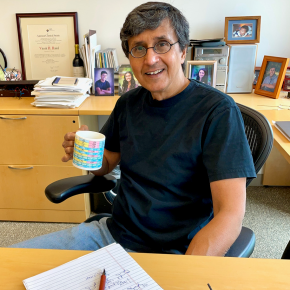CNRS Chemistry welcomes Viresh Rawal as the Ambassador in Chemical Sciences
On September 16, 2024, Viresh Rawal, Professor of Chemistry (University of Chicago (USA)) will start a series of lectures in several French CNRS laboratories as the Ambassador in Chemical Sciences in France*. Specialist in the synthesis of complex bioactive molecules, he tells us about his team's work in this field.
Considerable effort is focused on the total synthesis of complex bioactive natural products and the developments of methods, especially enantioselective** reactions. Can you tell us more about your team's work in this field?
My passion for chemical synthesis was sparked relatively early in my education. I realised that while most sciences involve the discovery, study, and understanding of nature, synthesis offers something more: an unlimited opportunity for creativity and invention. For example, the challenge posed by intricate bioactive molecules, such as anti-cancer drugs and antibiotics, can inspire countless solutions for their synthesis, the most interesting of which require chemistry that has yet to be discovered. In that spirit, much of the research activity in my group is aimed at discovering new ways to make complex molecules by exploring unique, even risky, strategies for different families of intricate natural products. Our goal is to devise concise, stereocontrolled, and high-yielding syntheses using strategies that expand our understanding of structure and reactivity. Central to this objective is the development of methods and catalysts for the enantioselective synthesis of our target molecules. For example, our research on the Aspidosperma*** family of indole alkaloids led us to discover that chiral salen-based complexes can catalyse Diels-Alder reactions with high yields and excellent enantioselectivities.
In the course of this work, we observed that TADDOL, a commercially available chiral diol, could function as a highly enantioselective catalyst, mimicking the behaviour of enzymes and antibodies through the use of hydrogen bonds to activate and orient the reactant. Further studies in this area led us to develop chiral ‘squaramide’ catalysts, which have proven to be highly effective for asymmetric catalysis. Nearly two thousand papers have been published from groups around the world describing new asymmetric catalysis methodologies using squaramides.
What progress can we expect in this area over the next few years?
The history of chemical synthesis is a long one, but the pace of progress in new synthetic methods, particularly enantioselective methods, has increased exponentially over the last 30 years. These advances have considerably broadened the arsenal of methods available to overcome the obstacles encountered in the total synthesis of bioactive molecules. There are now dozens of ways—some markedly different, while others are variations on each other—of carrying out the key bond-forming or bond-breaking steps leading to compounds of interest. Although the development of numerous solutions to a particular problem may seem secondary, this work is crucial to meeting the many challenges encountered in the synthesis of complex molecules. During a total synthesis campaign, it is all too common to obtain unexpected results, even though the sequence of reactions is apparently very simple and well mastered. These surprises (or disappointments) confirm what all synthetic organic chemists know only too well: apparently minor perturbations in the structure of a molecule can significantly alter its chemical reactivity. Consequently, there is a great advantage in having several approaches to adapt to this reactivity. One approach may be effective for a particular system, but a different approach may be required for another seemingly very similar system.
As far as enantioselective reactions are concerned, the increase in the number of chiral catalysts and asymmetric reactions has been breathtaking in recent years. I therefore expect this field to continue to flourish over the next few years, helped by the new approaches that AI and machine learning will make possible.
As Ambassador for Chemical Sciences in France, do you have any particular expectations of this upcoming tour?
I look forward to being welcomed into your world-class chemistry laboratories and discussing science with the many eminent scientists there. I already have many links with French chemistry. The first two students to obtain a doctorate under my supervision were French (Christophe Michoud and Claire Dufour). I have also had the privilege of visiting and lecturing in France, notably at the French American Chemical Society meeting in Cannes and the French Chemical Society meeting in Marseille. Being invited as an ambassador for the CNRS is a special privilege: I am looking forward to reconnecting with my long-standing chemical friends and establishing new links and collaborations with young researchers in the French academic landscape.
(*) In 2019, CNRS Institute of Chemistry has initiated a program called “Ambassadors of Chemical Sciences in France”. Its ambition is to give prestigious foreign researchers an opportunity to visit a series of French laboratories active in their field. These visits not only include top-notch conferences by the ambassador, but are also a good opportunity to establish preliminary contacts and foster international collaborations for the visited French laboratories.
(**) An enantioselective reaction is a chemical reaction that produces an excess of one enantiomer over the other. Enantiomers are optical isomers, i.e. molecules that are mirror images of each other and cannot be superimposed, like right and left hands.
(***) Aspidosperma alkaloids are natural organic compounds produced mainly by plants. They have a complex chemical structure that gives them a wide variety of chemical and biological properties.
Editor : CCdM
Lectures program
- 16/9/2024 - Toulouse, Laboratoire hétérochimie fondamentale et appliquée (Sami Lakhdar)
- 17/9/2024 - Marseille, Institut des sciences moléculaires de Marseille (Gaëlle Chouraqui)
- 18/9/2024 - Paris, Institut de chimie moléculaire et des matériaux d'Orsay (Aurélien de la Torre)
- 19/9/2024 - Rouen, Laboratoire Chimie organique, bioinorganique, réactivité et analyse (Michael De Paolis)
- 20/9/2024 - Paris, Collège de France (Louis Fensterbank)
